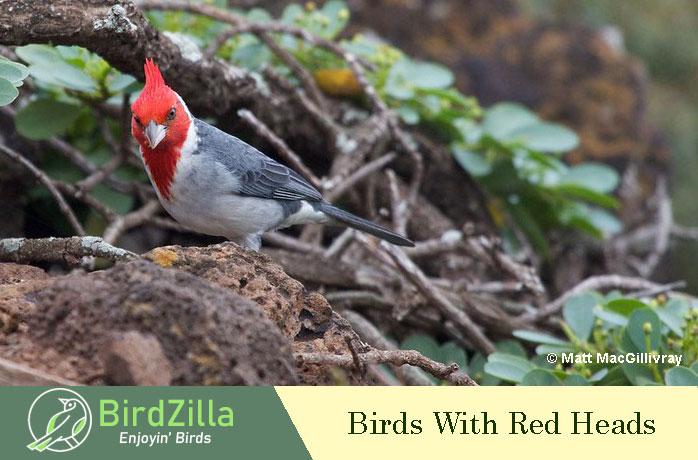
Birds with red heads are not uncommon, but it’s not often we stumble upon one.
Red is not the most frequently seen color in birds but some common species do have beautiful crimson and scarlet plumage. For example, the Northern Cardinal, Scarlet Tanager, and Summer Tanager are three of the better-known “red birds” in eastern North America. However, most birds with red in their plumage show this color on their heads.
Most of them have red highlights to look their best for potential mates. Learn about 15 of these beautiful red-headed birds below!
On this page
#15 Common Redpoll
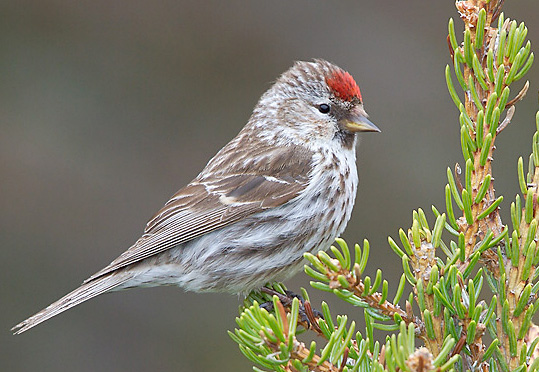
Photograph © Glenn Bartley.
The Common Redpoll is a dainty finch with a small, yellowish beak. The male has a small patch of dark, ruby red on his crown. He also has light and deep pink on the underparts, and a bit of black on the face and throat. This bird has dark streaks on his flanks and frosty gray back, and white in long, blackish wings.
The female is similar but has a smaller, darker red patch. She also lacks pink on the underparts.
This small finch breeds in brushy habitats in the far north. In North America, it winters in weedy fields in Canada and the northern USA.
#14 Acorn Woodpecker
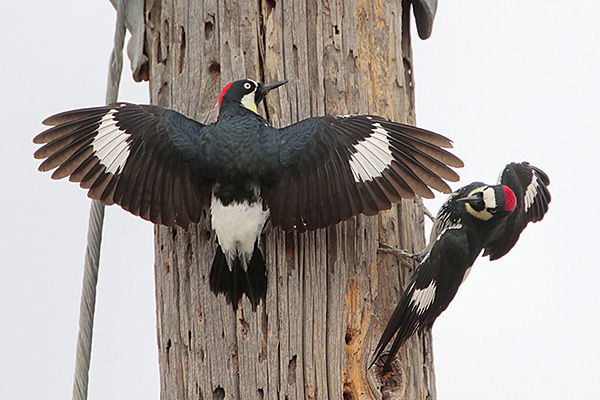
The Acorn Woodpecker is a medium-sized woodpecker with a scarlet patch on its head. In the male, this red patch is on the top and back part of his head. In the female, the red patch is smaller and only on the back part of her head.
Otherwise, both sexes are alike and have glossy black plumage with a creamy white face and throat, and white underparts with black streaks on the breast. In flight, their white rump and a white wing patches are obvious field marks.
Acorn Woodpeckers occur in oak forests from Oregon to California. They also live in Arizona, New Mexico, western Texas, and further south.
#13 Western Tanager
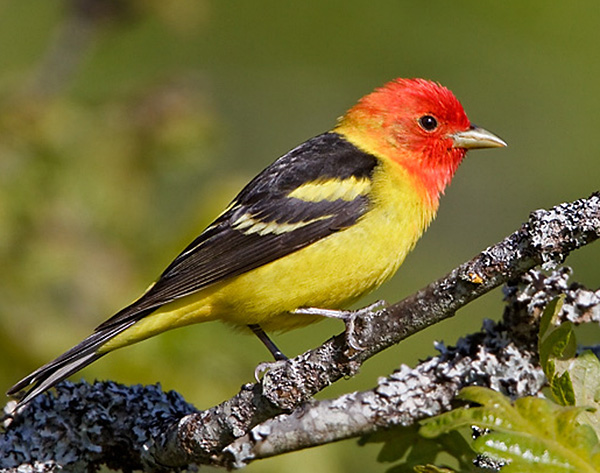
Western Tanager (Piranga ludoviciana) perched on a branch in Victoria, BC, Canada.
The male Western Tanager has beautiful rose-red on his head, blending into orange-red as it meets bright yellow on his neck and underparts. He also has a yellow rump, and a black back, wings, and tail. He has two pale wing bars, the upper one yellow and the lower one white.
The female Western Tanager lacks the male’s bright colors. She is olive and yellow with dark wings, a dark tail, and a gray back.
This species is a summer resident of coniferous forest and oak woodlands in western Canada and the western USA. In the fall, it migrates to Mexico and Central America for the winter.
#12 Pyrrhuloxia
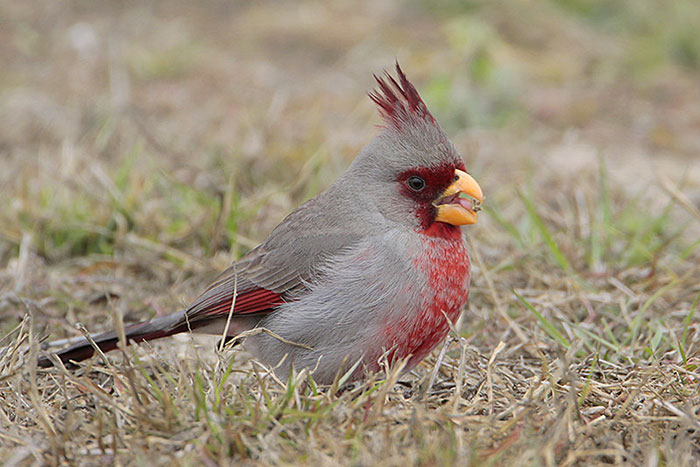
Photograph © Greg Lavaty
The Pyrrhuloxia is a gray, crested, finch-like bird with a rounded, yellowish bill. The male has beautiful rose-red highlights that form a vertical stripe from his face down the underparts to the undertail. These red colors make a lovely contrast with his ashy-gray plumage.
He also has deep rose-red on his crest, wings and tail. The female is grayish brown and buff with dull red on her crest, wings, and tail.
Also known as the “Desert Cardinal,” this handsome bird lives in arid habitats in southern Arizona, southern New Mexico, western and southern Texas, and Mexico.
#11 House Finch
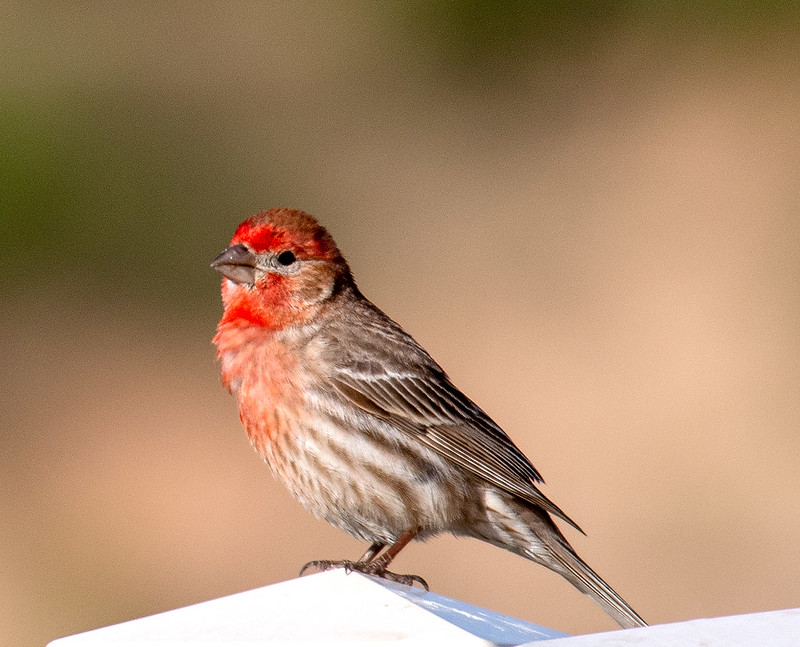
© John Hansen
The male House Finch is a small, sparrow-like bird with a ripe strawberry red head and pink-red breast. Males can also be red-orange. They have a grayish, conical beak, pink-red highlights on gray-brown upperparts, and gray-brown streaks on a pale belly.
The female House Finch lacks red and resembles a dull brownish finch with a uniform, gray-brown face and streaked underparts.
House Finches live in urban areas, parks, and in arid habitats. We can see them in parts of southern Canada, the western USA, Mexico, and in much of the eastern USA.
#10 Vermilion Flycatcher
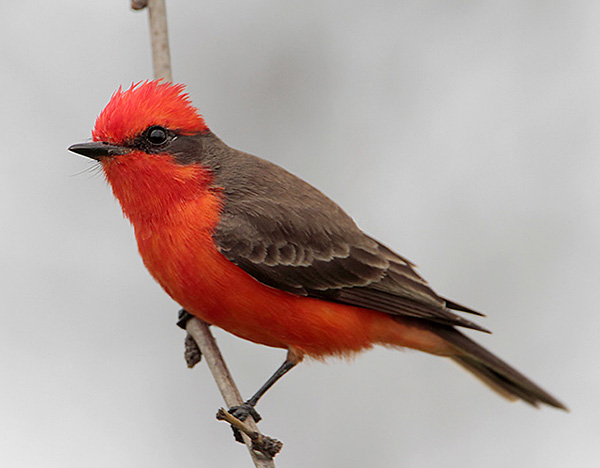
The male Vermilion Flycatcher is a small, flaming red and black bird. He has glowing red on the head and is more orange-red on his belly. He also has a black bill, narrow black mask, and black upperparts with some white in the wings.
The female Vermilion Flycatcher lacks red and is mostly gray above. She has gray streaks on a white breast and a pink belly and undertail. She also has blackish wings and a black tail with some white. Young birds are like females but have yellow instead of pink.
This species frequents riparian zones and brushy habitats from California to Texas.
#9 Red-faced Warbler
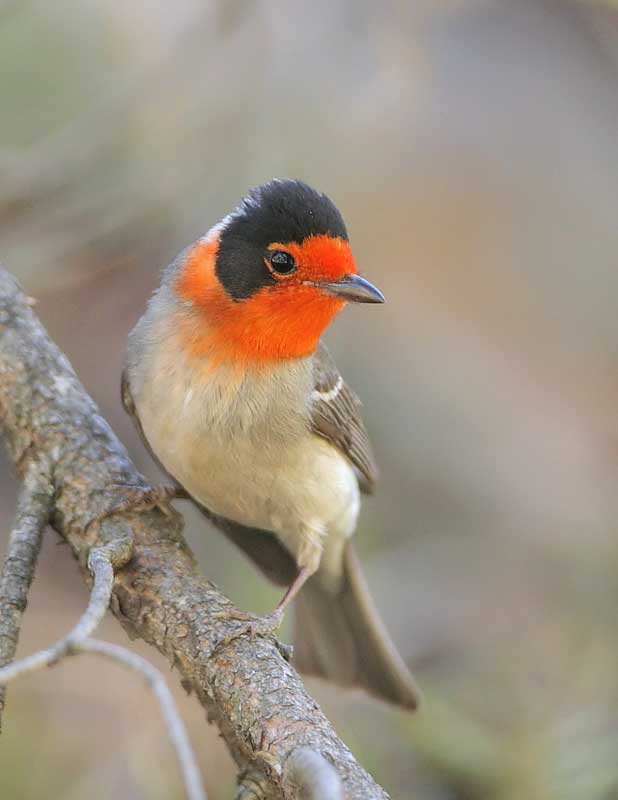
The Red-faced Warbler is a small gray bird with bright, candy red on its face, head, and throat. This red color contrasts with deep black on the crown and side of the face. It also has a small white spot on the back of its head and on its rump.
The rest of the upperparts of this handsome little bird are gray, and most of the underparts are white. Both sexes look alike, although females aren’t as bright as males. Young Red-faced Warblers have paler pink-red on their heads.
The Red-faced Warbler breeds in montane evergreen forests in Arizona, New Mexico, and Mexico.
#8 Downy Woodpecker
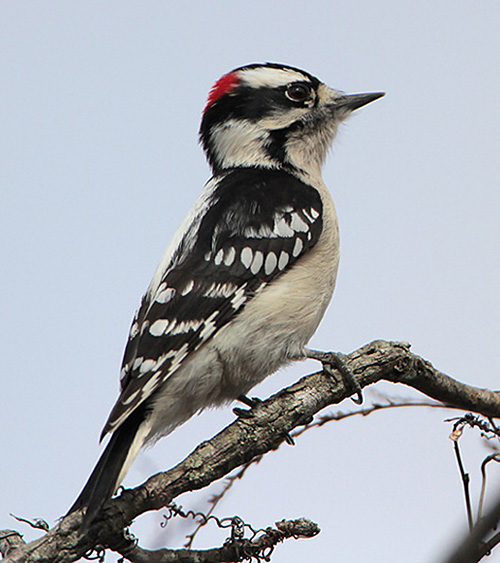
Photograph © Greg Lavaty.
The male Downy Woodpecker is a small, black and white woodpecker with a bright red patch on the back of his head. He also has a short, pointed beak, white underparts, and a large white patch on the back.
The female Downy Woodpecker looks like the male but lacks the red spot on her head. Both sexes also have a black and white, pointed tail with a few small black marks in the outer tail feathers.
Downy Woodpeckers are common and visit feeders in parks, gardens, and woodlands in much of Canada and the USA. They are absent from the far north and the American southwest.
#7 Red-bellied Woodpecker
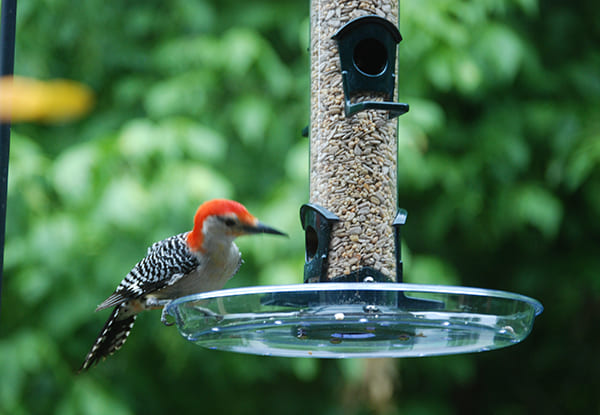
The Red-bellied Woodpecker is a medium-sized woodpecker with bright red on its head. The male has a bright red crown and nape, a reddish-orange spot above the bill, and a gray face. It also has gray underparts with a small red-orange patch on the belly.
Like the male, the female Red-bellied Woodpecker has black and white barring on the wings and back, a white rump, and a black and white tail. However, the red on her head is restricted to the nape.
Young birds have gray heads, or have some orange on the nape.
Red-bellied Woodpeckers are common birds in wooded areas in the eastern USA and southern Ontario.
#6 Red-crested Cardinal
The Red-crested Cardinal is a small to medium-sized, gray and white bird with a tall, crimson crest. It also has crimson red on the face and throat that descends to a point on the upper breast.
Both sexes are similar and have gray upperparts, white underparts, and a pale conical beak. Instead of red, young birds have orange-brown on their crest and head.
Red-crested Cardinals are native to South America. They live in tropical shrubland habitats from Bolivia to Argentina. They have also been introduced to Hawaii, where they are a common bird and visit feeders.
#5 Redhead
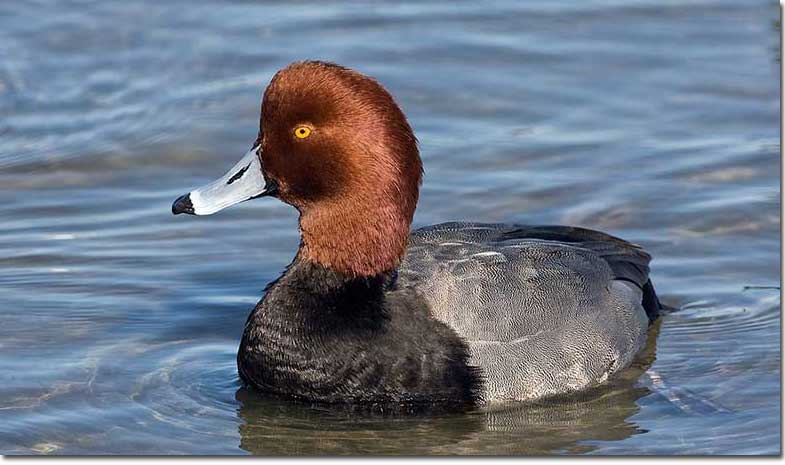
The male Redhead is a medium-sized gray and black duck with a rich, glossy, reddish-brown or chestnut head. It has yellowish eyes, a pale blue-gray beak with a black tip, and a mottled gray back and flanks. It also has a black breast, black rump, and black under the tail.
The female Redhead lacks the reddish-brown head and is tawny brown. She has some pale buff markings on the head, and a dark gray beak with a black tip.
Redheads occur in lakes and bays in Alaska, and central and western North America. They winter in parts of the southern and eastern USA and Mexico.
#4 Cassin’s Finch
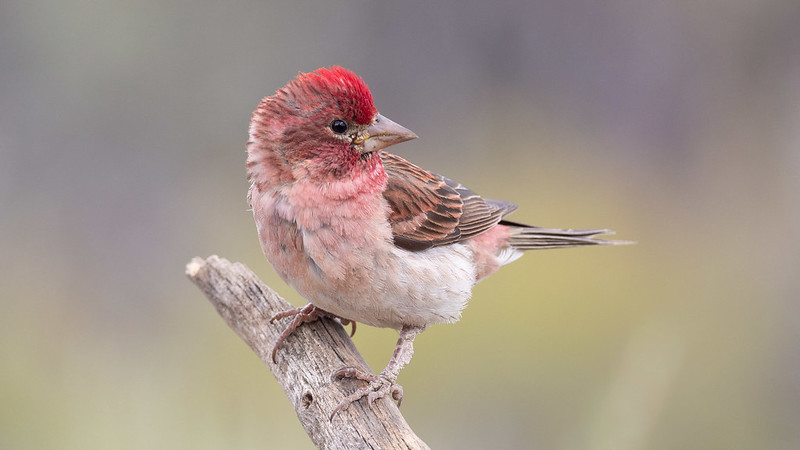
Cassin’s Finch. © David Renwald
The male Cassin’s Finch is a sparrow-sized finch with a lovely, rose-red cap. It has reddish-pink on the face, breast, wings, tail, and rump. The male also has some dark marks on the face and a white belly.
Like the male, the female Cassin’s Finch has a large, pale, conical beak and long wings, but she lacks red. Instead, females are grayish brown above and white below with heavy streaking.
The Cassin’s Finch frequents dry coniferous woodlands in the Rocky Mountains and other parts of the western USA and Canada. In winter, it can descend to lower elevations and migrate to Mexico.
#3 Red-breasted Sapsucker
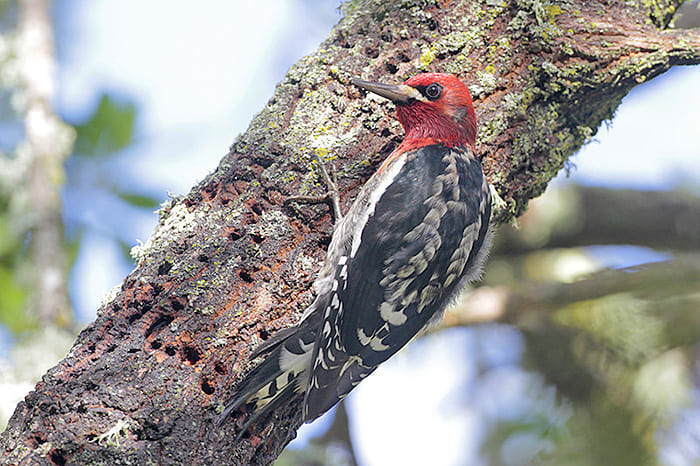
The Red-breasted Sapsucker is a small to medium-sized woodpecker with a velvet red head and breast. They also have some white on their face, black and white mottling on their back, a white rump, and a white patch on mostly black wings.
This woodpecker also has a pale yellow belly. The sexes look similar and have the same deep red color, but females can have more white on the face. Young birds have a sooty brown head and breast.
The Red-breasted Sapsucker is common in Pacific Coast coniferous forests from southern Alaska to California and Nevada.
#2 Pileated Woodpecker
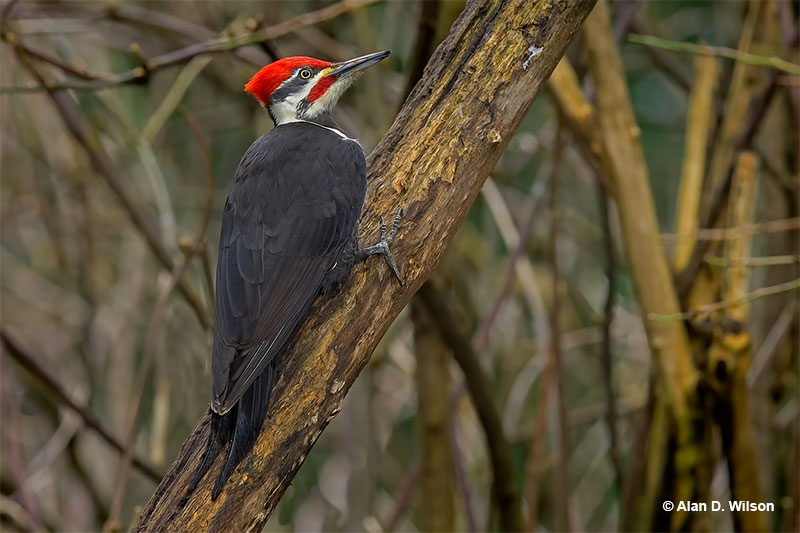
The Pileated Woodpecker is a huge woodpecker with a red crest. On males, the entire crest and top of the head is crimson, and it has a red moustache mark. On females the red patch on the crest is much more limited, and they lack the male’s red moustache.
This crow-sized woodpecker is mostly black with white on the neck, face, and under the wings.
Pileated Woodpeckers live in mature forests in much of Canada, in the Pacific Northwest south to California, and in woodlands east of the Great Plains. As long as enough forest is present, they are common and conspicuous birds.
#1 Red-headed Woodpecker
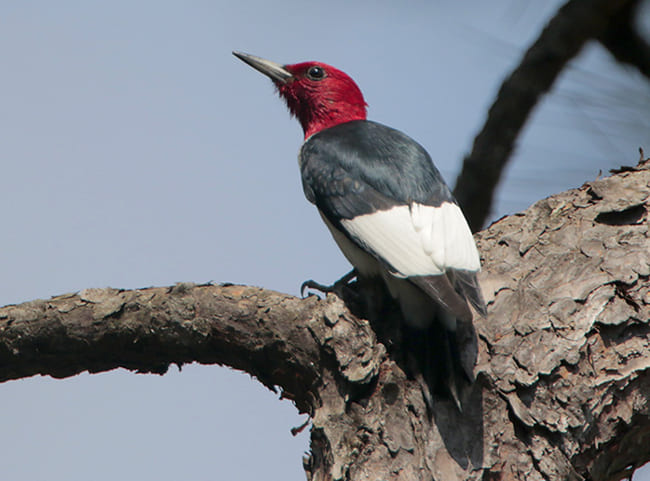
The Red-headed Woodpecker is a robin-sized woodpecker with a deep, velvet red head. The plush red head of this bird contrasts with its glossy black back and snow-white underparts.
Both male and female Red-headed Woodpeckers have this beautiful field mark, and also have a big white patch in the wings and white on the rump. Young birds have the same pattern as adult birds but don’t have any red at all. Instead, they have brown heads and gray streaks on their underparts.
Red-headed Woodpeckers live in open oak woodlands and park-like habitats from the Great Plains east to New York and Florida.


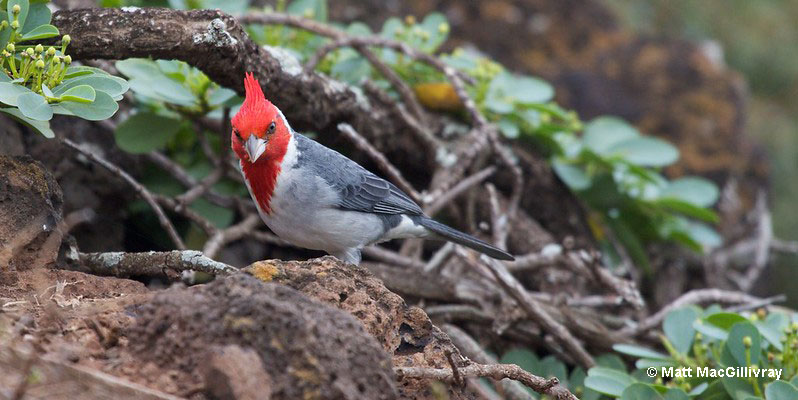
Richard Sattanni
Friday 1st of March 2024
I have a photo of a bird with red head, red underbelly, and black or brown back, yellow or white small w pointed beak. Could you send me an email address to send email attachment of photo. Would be appreciated.
Sam Crowe
Tuesday 5th of March 2024
Feel free to send it over its (at) birdzilla (d0t) com
Richard Sattanni
Thursday 29th of February 2024
Have some bird photos. Trying to find out type of bird.
N Meyer
Tuesday 20th of February 2024
We have a red headed bird without barring on back, a dove gray belly, long beak. What is it? About 9"
Patrick O'Donnell
Wednesday 21st of February 2024
It sounds like it might be a woodpecker but it's hard to say which species. Where did you see it (which state)?